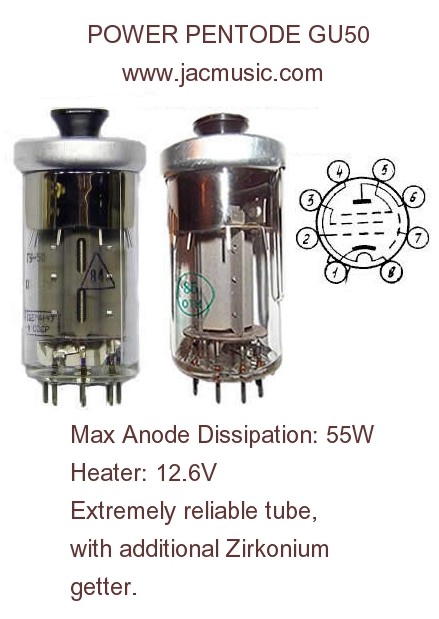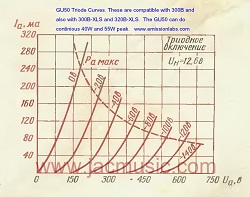Portrait of a tube
GU50

GU50 is one of the most curious tubes to find.
Some items:
- Prices. while I write this text, prices are quite low. Concerning NOS prices, never, ever believe the wisdom, ventilated on the forums. If there is one place to pick up stupidities about tube prices, it is there. Believe it or not, but future prices are made by future demand and future supply, and nothing else. Supply for GU50 is good at this moment, but this is only because some quantity was released by the military. This quantity, I do not know, but I can tell you, it came suddenly, and everybody tried to sell them cheaper than the others, because they have no choice. Still low NOS never drove up demand with any tube. So the larger dealers may have picked them up by many 1000's and sell them off in quantities of 100 to small dealers, for twice the price, making some quick money. These, then were all competing against each other, and against Russian private sellers. However the main source of the supply always dried up probably long ago. Still nothing happens on the market, because some 100 small dealers still have stock, and keep competing with each other. Since appr 2010, this tube begins to attract small manufacturers, and small companies, and prices are going up. Where prices will go, I can not say, I only know the direction, and no NOS tube ever got cheaper. I have been saying since the year 2000, that those 3 Euro tubes like C3g will one day cost 100 or 200 Euro, but nobody believed it, because you could buy them from 50 sellers for prices between 3 and 10 Euro. There so much for sales everywhere. Which was so indeed. only, I know first hand, this was all from one single source. That is why I was so sure. I expect with GU50, the situation is not the same, but perhaps similar. Well I just expect it, but it seems to go this way. Though the looks of GU50 is not nice, and large OEMS do not enthusiastically jump on this tube, because there is no new production. So that probably keeps the price in the mid field.
- The Anode heat. I belong to the old school, which reads data sheets as a main source for technical information. Just I can't read Russian. From the pictures I see in the internet, there are many Russian mobile applications, and also I see the tubes always in thick metal cylinders. This indicates high frequency use, or perhaps even anti-nuclear pulse applications, but that is just a wild guess. Those encapsulated applications of course will heat up the tube very much. The designers made the best out if it, by using (from what it appears to me) a Zirconium plating of the anode, and for sure I see a Zirconium getter pill inside the tube, used together with a normal Barium getter. The tube has a total of four (!!) Getters. Zirconium is a metal which can maintain and even restore high vacuum. Whereas Barium can also maintain vacuum, but not as good Zirconium Moreover the cleaning effect of Zirconium under great heat is remarkable, and unlike Barium, this getter doesn't damage from excessive heat. So this tube is made for great heat, that seems sure. Strangely, what also helps for this, is the relatively low heater power. The heat from the filament becomes quite a stress for the first grid, when the anode is very hot as well. So we see here another factor making the tube heat resistant. The next factor is the gold plated grid, because gold is an emission killer, and any Barium which (always) migrates to the grid, will not cause grid emission there. The glass bulb is hard glass, also indicating great heat. I have seen some crazy videos of people out glowing the anodes, and the tube was still fine afterwards. Do not believe this to be "good" or even intelligent, because it definitely cuts off a large piece of the lifetime, every time you do it, but indeed unlike tubes such as KT88 it does not instantaneously damage from that.
- Pentode Application. All together this is a good work horse for army applications. The tube seems very nice for high frequency, and some people build Tesla Coils applications with it, same as EL509 can do. The data sheet shows a limitation of 300V for the screen grid, and if you go above, the screen grid may damage. However during tube testing, I once had a case, where the anode was loose, so the complete cathode current went through the Screen grid, out glowing it bright yellow, some color as an 845 tube heater. Very bright! Afterwards, this whole tube tested simply fine still. So this tube is strong as a tank. I have not tested the following, so when you do, you really need to measure it better, but I believe in ultra linear mode, probably the screen grid can be much higher than 300V. Since the DC bias in Ultra linear is the same as Triode mode, and in triode mode, the data sheet allows very high voltage.
- Triode Application. This is remarkable, because in triode mode, the tube curves are similar to 300B.
 By the official factory data sheet that is. So to take away the (small) doubt about the G2 limitation, simply use to triode mode, and there are 100's of 300B schematics to choose from. Moreover, Push-Pull application is a known tube killer application for 300B, because of it's (limited) pulse capability, but really with GU50 I think this tube is very suited for this too. When looking at the triode curves, it can be seen, they loose some linearity at high voltage, low current but there is no need to go there, and no need to sweep the curve through this area too, for audio. The are excellent at medium voltage and relatively high current. Like at 380V, 80mA is a very nice working point, same as 300B. Yet Gu50 probably can go at 380V, 100mA also very nice, but 300B would like appreciate that.
By the official factory data sheet that is. So to take away the (small) doubt about the G2 limitation, simply use to triode mode, and there are 100's of 300B schematics to choose from. Moreover, Push-Pull application is a known tube killer application for 300B, because of it's (limited) pulse capability, but really with GU50 I think this tube is very suited for this too. When looking at the triode curves, it can be seen, they loose some linearity at high voltage, low current but there is no need to go there, and no need to sweep the curve through this area too, for audio. The are excellent at medium voltage and relatively high current. Like at 380V, 80mA is a very nice working point, same as 300B. Yet Gu50 probably can go at 380V, 100mA also very nice, but 300B would like appreciate that. - The Bakelite tops you can screw off, and becomes nice feet for a small amplifier. No joke, these tops are lovely made, and really nice for this.
- Other Sources. There is a Chinese FU50, supposedly still made, though they said this about other tubes too, but it was NOS. So I can not confirm this. The Telefunken designation was LS50. EL152 is somewhat similar, but sure not the same.
- Testing. The Russian L3-3 tester has an original test card and a socket, directly for this tube. It has the designation ГУ-50.
This is the poor man's 300B-XLS.
Apart from the socket, and 12.6V indirect heater, this tube in Triode mode can replace 300B directly, and most 300B-XLS and 320B-XLS applications as long as you stay below 40Watt continuous.
Tube |
Continuous. Dissipation |
Peak Dissipation |
|---|---|---|
GU50 |
40W |
55W |
300B |
36W |
40W |
300B-XLS |
40W |
65W |
320B-XLS |
40W |
65W |

PICTURES + SCHEMATICS + Data sheet HERE
WE SELL THE SOCKET FOR THIS TUBE ALSO.